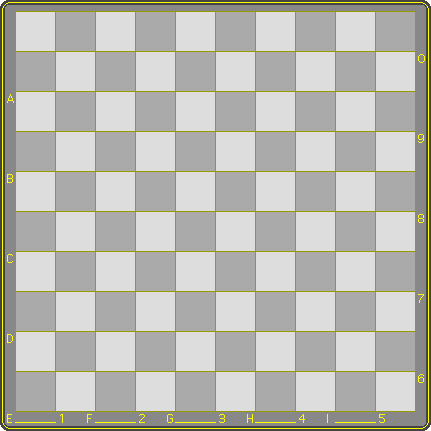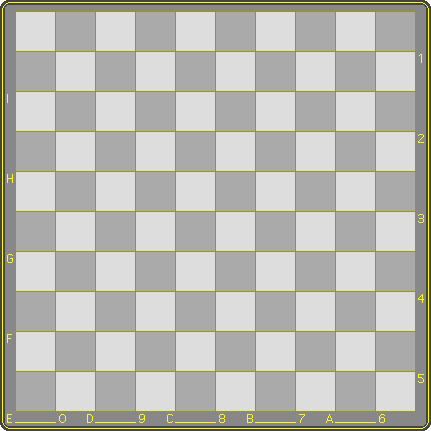Page 2 of 11
- Bushka
Anyone who has ever played Fanorona probably still remembers the shock. To call the game 'volatile' is definitely an understatement. It features capture 'by approach' as well as 'by withdrawal' - a one step move directly towards or away from the target - and in either or both not only the stone approached or withdrawn from is captured, but an unbroken line of like-colored men behind it.
I found capture by withdrawal uninviting. But capture by approach, in its simplest form, is a 'two men on three cells' scenario reminiscent of Draughts. Why would it render less of game if transposed to the framework of Draughts? So I started out with a simple transposition.
A new monkey
With a new monkey in the cage, differences immediately emerged.
Using the initial set-up of Draughts, the forces were awfully close: any white opening move resulted in a double capture by black, followed by a single one by white. It didn't take long to find out white started out on the wrong foot. So I converted the board to 9x11 with dark corners, 17 men per side and three vacant rows between the forces, instead of two. Which was an improvement.
Also, there was no need for a rule concerning a man reaching the back rank in a capture: a men simply cannot reach the back rank in a capture.
Finally, in Draughts a piece may change direction in a multiple capture, but it cannot make a 'one-eighty' because it would jump the same piece twice. In Bushka, as the embryonic game was coined, a piece must change direction. However, it can and often must make a 180o turn to proceed in a capture!
Apart from these obvious differences, the game remained very much the same: a long-range king, compulsory capture, precedence of majority capture, captures that must be completed before the pieces are removed and pieces that may not be contacted more than once during a capture, while squares may be visited more than once. All these refinements of Draughts eventually turned out to serve Buska the same way: flawlessly.
Eventually, because the dry transposition turned out less than satisfactory. Draught's combinatorial power is based on jumping, whereby the vacant squares that make up the route of a capture are disconnected by the very pieces that are being jumped. In Bushka the capturing piece doesn't jump, so it needs connected vacant squares on its route. The game 'worked', but it was an unspirited affair. Not quite what I suspected to be hiddden there. I wanted to see the mechanism turn itself into an organism, as much as it did itself. So I reflected, and reflected and reflected some more. Sometimes things take a while to come together the right way. It's never bad to practise some patience and let the unsolved be unsolved for the time being. You can't force an unwilling game anymore than an unwilling donkey.
This is how the donkey transformed into a race horse: at a certain intersection I reverted to Fanorona and the fact that allowed the capture of a whole line of men. That looked like something that might provide what was needed. It was a way to carve deeper into an opponent's position. But intuitively it seemed off balance, one man axing a whole phalanx. It would bring back the extreme volatility of its ancestor, and not the 'spirit' I sought.
Linear movement & capture
In retrospect the solution was rather obvious: let the capture of a line of men be by a line of men. If there are two opposing lines of men with one vacant square in between, the one who's turn it is can capture the opposing line by approaching one step, as a whole. Well ... not necessarily as a whole. The capture would be allowed as long as it was 'linear', that is: at least with two men. So if the capturing line consisted of say four men, the captor would have the choice of proceeding with the font two men, or the front three, or the whole line. I didn't have to reflect very long to see that 'linear movement' was a logical precondition for linear capture. That would, if nothing else, speed up things.
There's always a tipping point where the prey is trapped and the rest is techique: at this point I knew I had the game. There were two loose ends however, an obvious one and another as yet hidden. The obvious one presented itself as two distinctively different ways of capture, one with single pieces and the other linear.
Linear movement and capture were easily trimmed down to specifics: a line should always consist of men of one color and be unbroken. A king would never be part of a line. A line would be allowed to move one step forward, typically by taking any man behind the frontman and leapfrogging it to the vacant square in front. In a capture a line would be allowed to move either forwards or backwards. Whether capturing or not, a line would not be allowed to make more than one move per turn.
Easy enough. But how about the precedence of majority capture? I felt the cooperation of two such distictively different ways of capture to be somewhat squirmish, almost uncoordinated. The monkey was running hands and feet, but tripping one over the other. One could easily see how many men a linear capture would render, but the front man alone might also have a normal multiple capture - by now coined 'piece capture - at his disposal. Precedence of majority capture would eventually be enough to sort it out, but the two ways of capture seemed to interfere rather than to cooperate, Too many choices were putting a strain on clarity.
Wrapping it up
The final step was a logical one. I gave the game what it wanted: precedence of linear capture. It provided instant clarity by reducing choice. No longer could a single frontman, or any single piece for that matter, operate where a linear capture was required. No need to look further except when more than one linear capture was possible, and in that case of couse majority capture would precede. Bushka was born.
Back to square 10x10no Sound - Flip board to moveFrom a game between the inventor (Black) and Demian Freeling - White has just reached promotion with c78. To parry the threat c87, trapping the man on g7, Black has moved gh7 and White found this neat little combination
There was this second loose end remember? The hidden one. It emerged very slowly. Bushka, now released, turned out to relate to Draughts as karate relates to judo. However, despite three vacant rows between the forces, the opening appeared to be boobytrapped at almost every intersection. The compact initial position was full of lines just waiting to be captured, and they were. More often than not the battle turned straight into a massacre. Backtracking, mistakes would be found, tactics recognized, and opening alleys carved out. I started on an opening book, because the alleys were so narrow and so may moves were refuted on both sides, sometimes bluntly, sometimes very ingeniously.
Further down the line, in the middle game, positions diverged adequately into sometimes very subtle endgames, full of surpising combinations, even with extremely reduced material. Kings were ever so powerful as in Draughts, but unlike Draughts, three kings turned out to be enough to trap a lone one, suggesting a sharper endgame and a smaller margin of draws. It was great!
After a couple of years however, the opening was well documented and enough time had passed to take a step back and have a fresh look. I cherished my opening analysis, but I saw that it was both limited and fairly complete. To not get your head blown off, you had too walk one of only a few available tightropes. The game, I had to admit, started in too narrow a jacket. It demanded more of a middle game type of freedom in the opening, and the solution was in some ways comforting, because although it meant my analysis was down the drain, at least we were back to the regular square board, albeit with 15 men each and four ranks between the forces.
So that was the final step, and I didn't start on a new opening book, because it would be a far bigger book now. For a Draughts player the gap between the forces may seem wide, for a beginning Bushka player it will turn out to be unexpectedly narrow! There are more alleys to explore now, for sure, but the game is boobytrapped throughout and opening mistakes still lurk from move one.






